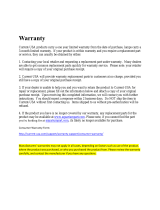
drobo.com | Getting Started Guide for Your Drobo B800i |
11
Installing Drobo Dashboard from the Website
You can install Drobo Dashboard from www.drobo.com/support/updates.php. Note,
however, that the latest version may be released with new products (on a Resource CD) for
a short period of time before being made available on this website.
1. Using your browser on an active Internet connection, navigate to
www.drobo.com/support/updates.php.
2. Locate the link for the latest Drobo Dashboard software and click on it.
3. If you’re given a choice to install (or run) Drobo Dashboard or save the installation
file to your computer, choose to save the file to your computer. Locate the file
and double-click on it to begin installation. (You can delete the installation file
afterwards.)
4. If warning messages appear, asking if you’re sure you want to open and/or install
the file or program, click the OK or Run button, as appropriate, to continue with the
installation.
5. A dialog box may appear, asking you to select your language from the drop-down list.
After doing so, click the OK button.
The Drobo Dashboard Installation Wizard appears, preparing to install.
6. Continue with the installation process, following from step 4 in the “Installing Drobo
Dashboard from the Resource CD” section.
Inserting the Hard Drives
After installing Drobo Dashboard, you are ready to insert hard drives into your Drobo B800i.
For more information on hard drive requirements, see “Checking the Hardware You Need”
on page 5.
Warning: Any pre-existing data on the hard drives will be erased, as the drives will
be formatted. If you wish to keep the data, copy it to another drive or medium before
using with your Drobo device.
Note: Once you insert the drives into your Drobo device, they function as a unit or
“pack.” To access the data on them, you will need the entire pack.






















